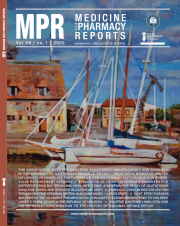Implications of type 1 diabetes mellitus in the etiology and clinic of dento-maxillary anomalies - questionnaire-based evaluation of the dentists’ opinion
DOI:
https://doi.org/10.15386/mpr-2822Keywords:
type I diabetes, dento-maxillary anomaly, questionnaire, respondent, oral pathologyAbstract
Background and aims. Type 1 diabetes is one of the most common chronic childhood diseases, which can be diagnosed at any age, with implications on the general development, but also on the craniofacial structure. It is widely speculated that diabetes occurs when inherited genetic characteristics are triggered by environmental factors. Oral pathology is complex and it includes a series of clinical entities: dental caries, periodontal disease, dento-maxillary anomalies, diseases of the oral mucosa, which implies a significant responsibility for the doctor, but also for society. This study aims to highlight the association of dento-maxillary anomalies with juvenile diabetes, starting from its increased prevalence among children and adolescents, the oral manifestations of diabetes mellitus and its influence on the oral microbiome, the increased incidence of periodontal and dental diseases, by means of a questionnaire.
Method. A cross-sectional study was carried out on a number of 60 dentists, between 01.01.2023 and 01.03.2024, using a questionnaire with 14 items, which was distributed by e-mail and social networks to dentists of different specialties, from various university. Before completing the questionnaire, the doctors were informed about the purpose of the study and that their answers were anonymous and did not imply any responsibility.
Results. Our results indicated awareness of the association between oral health, the presence of dento-maxillary anomalies and the pathology of type 1 diabetes, among dentists of different specialties. The most frequent changes that occur in the oral cavity in the examined patients are represented by carious lesions, reported by 21 examiners (35.00%), of which 18 (39.13%) are female, aged between 25-35 years.
Among the reported dentomaxillary anomalies, those of Angle class II were the most frequent - 17 examiners (28.33%), of which 12 (26.09%) are female reported the presence of these anomalies. The presence of Angle class I anomalies was reported by 13 examiners (21.67%) of which 9 (19.57%) are female, while 6 examiners (10.00%) reported the presence of Angle class III anomalies.
Conclusions. The evaluation of modern therapeutic methods through questionnaires distributed online represents a feedback of the tested activity and shows that most doctors know the correlations between diabetes and oro-dental diseases and have an obvious healthy attitude. The possible association between oral diseases and the presence of type 1 diabetes was reported by most of the dentists interviewed, however the information on the correlations between oral health and the presence of type 1 diabetes in children was not sufficiently explored by dentists. The dentist must know the clinical particularities of diabetes mellitus and its implications on the oral status, in order to be able to intervene effectively in reducing the oral and systemic complications of diabetes.
Downloads
Published
How to Cite
Issue
Section
License
The authors are required to transfer the copyright of the published paper to the journal. This is done by agreeing to sign the Copyright Assignment Form. Whenever the case, authors are also required to send permissions to reproduce material (such as illustrations) from the copyright holder.

The papers published in the journal are licensed under a Creative Commons Attribution-NonCommercial-NoDerivatives 4.0 International License.

